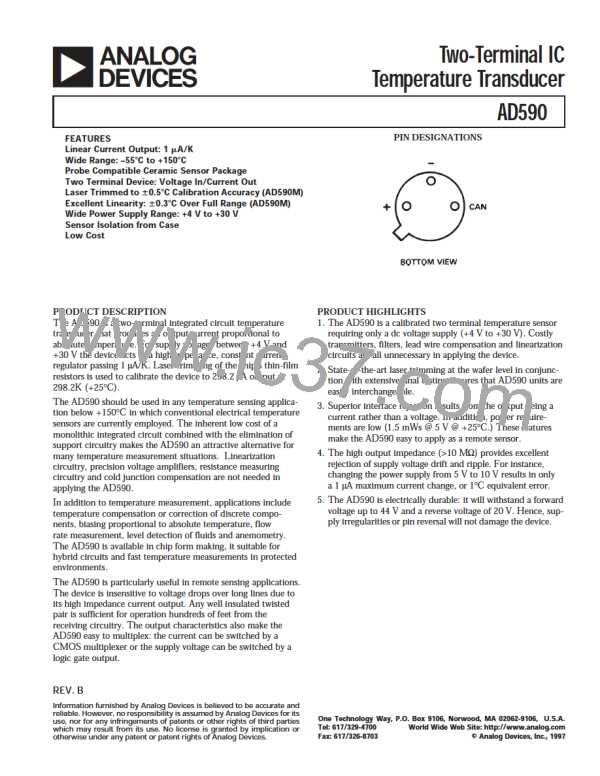AD590
thermal connection. Power source P represents the power
dissipated on the chip. T he rise of the junction temperature, TJ,
above the ambient temperature TA is:
T J −T A = P (θJC + θCA
)
Equation 1
T able I gives the sum of θJC and θCA for several common
thermal media for both the “H” and “F” packages. T he heatsink
used was a common clip-on. Using Equation 1, the temperature
rise of an AD590 “H” package in a stirred bath at +25°C, when
driven with a 5 V supply, will be 0.06°C. However, for the same
conditions in still air the temperature rise is 0.72°C. For a given
supply voltage, the temperature rise varies with the current and
is PT AT . T herefore, if an application circuit is trimmed with
the sensor in the same thermal environment in which it will be
used, the scale factor trim compensates for this effect over the
entire temperature range.
Figure 7A. Two Tem perature Trim
Table I. Therm al Resistances
Medium
θJC + θCA (؇C/Watt) τ (sec)(Note 3)
H
F
H
F
Aluminum Block
Stirred Oil1
30
42
10
60
0.6
1.4
0.1
0.6
Figure 7B. Typical Two-Trim Accuracy
Moving Air2
With Heat Sink
Without Heat Sink
Still Air
With Heat Sink
Without Heat Sink
45
115
–
190
5.0
13.5
–
10.0
VO LTAGE AND TH ERMAL ENVIRO NMENT EFFECTS
T he power supply rejection specifications show the maximum
expected change in output current versus input voltage changes.
T he insensitivity of the output to input voltage allows the use of
unregulated supplies. It also means that hundreds of ohms of
resistance (such as a CMOS multiplexer) can be tolerated in
series with the device.
191
480
–
650
108
60
–
30
1Note: τ is dependent upon velocity of oil; average of several velocities listed
above.
2Air velocity 9 ft./sec.
3T he time constant is defined as the time required to reach 63.2% of an
instantaneous temperature change.
It is important to note that using a supply voltage other than 5 V
does not change the PT AT nature of the AD590. In other
words, this change is equivalent to a calibration error and can be
removed by the scale factor trim (see previous page).
T he time response of the AD590 to a step change in tempera-
ture is determined by the thermal resistances and the thermal
capacities of the chip, CCH, and the case, CC. CCH is about
0.04 watt-sec/°C for the AD590. CC varies with the measured
medium since it includes anything that is in direct thermal
contact with the case. In most cases, the single time constant
exponential curve of Figure 9 is sufficient to describe the time
response, T (t). T able I shows the effective time constant, τ, for
several media.
T he AD590 specifications are guaranteed for use in a low thermal
resistance environment with 5 V across the sensor. Large
changes in the thermal resistance of the sensor’s environment
will change the amount of self-heating and result in changes in
the output which are predictable but not necessarily desirable.
T he thermal environment in which the AD590 is used deter-
mines two important characteristics: the effect of self heating
and the response of the sensor with time.
Figure 8. Therm al Circuit Model
Figure 8 is a model of the AD590 which demonstrates these
characteristics. As an example, for the T O-52 package, θJC is
the thermal resistance between the chip and the case, about
26°C/watt. θCA is the thermal resistance between the case and
the surroundings and is determined by the characteristics of the
Figure 9. Tim e Response Curve
REV. B
–6–

 ADI [ ADI ]
ADI [ ADI ]